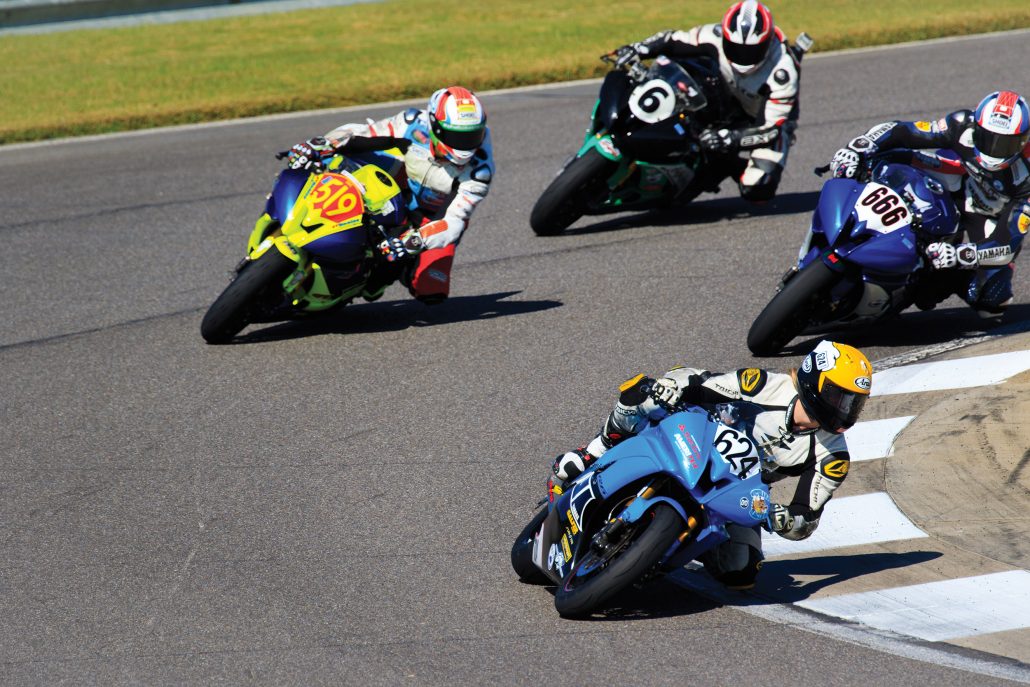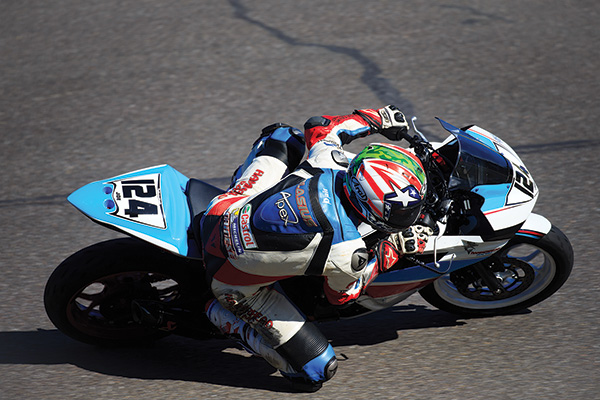AMERICAN MOTORCYCLIST OCTOBER 2018
Racing into Fall
The AMA Road Race Grand Championship Kicks Off Oct. 25
By Michael Marino
For amateur road racers in the United States, the end of October is when they will carve their way around Barber Motorsports Park at the AMA Road Race Grand Championship, the nation’s premier amateur national road racing championship, Oct. 25-28.
Novice and expert road racers will pilot motorcycles of a wide range of classes around the picturesque, Leeds, Ala., facility’s 2.38-mile, 17-turn road course. The event is operated by WERA Motorcycle Roadracing and run concurrently with WERA’s popular Grand National Finals event.
Premier Amateur Championship
The AMA Road Race Grand Championship has featured a number of MotoAmerica’s current and up-and-coming racers, including two-time MotoAmerica Supersport Champion Garrett Gerloff, 2016 MotoAmerica KTM RC 390 Cup champion Brandon Paasch, plus Nick McFadden and Nate Minster.
While future professionals give experienced amateur riders a challenge, the event features classes for riders of all skill levels. The 2017 edition of the event featured 174 entries across 13 competition classes.
The AMA Road Race Grand Championship is a single national championship event that determines AMA amateur and expert national road racing champions. Class winners are recognized as AMA National Champions and are awarded AMA National No. 1 plates.
Class winners also will be honored at the AMA Championship Banquet on Dec. 8, as part of AMA Legends & Champions Weekend in Columbus, Ohio.
Several AMA awards will be up for grabs at the event.
The most prestigious of those awards is the Nicky Hayden AMA Road Race Horizon Award, which recognizes the rider best prepared for the professional ranks, based on attitude, enthusiasm and past performances as an amateur.
Past winners include three-time AMA Superbike Champion and 2009 World Superbike Champion Ben Spies, Daytona 200 winner Jason DiSalvo and current MotoAmerica racers Hayden Gillim, Jake Lewis, Anthony Mazziotto III, and Joseph Blasius.
Other AMA awards that will be handed out at the event include the AMA Novice Road Racer of the Year, AMA Youth Road Racer of the Year and AMA Vet/Senior Road Racer of the Year.
“We are excited to get the AMA Road Race Grand Championship underway in October,” AMA Track Racing Manager Ken Saillant. “It is a great event and WERA Motorcycle Roadracing did a great job with it last year. We look forward to seeing our amateur road racing program continue to grow.”

Racers navigating Barber Motorsports Park’s Turn 2 at 2017 AMA Road Race Grand Champions
Classes And Skill Levels
The event’s competition classes allow a wide range of skill levels and machinery to compete for national championships.
Of the event’s 13 competition classes, six are designated novice classes. Additionally, six classes are designated “superstock” classes that heavily restrict motorcycle modifications. Those classes allow riders to compete on lightly-modified street bikes and create a more level playing field for racers on a budget.
…WERA Motorcycle
Roadracing did a great
job with it last year. We
look Forward to seeing
our amateur road racing program continue to grow.
For 2018, there will be one class change. The Formula 3 Class will be replaced with a 300 Superstock Class. The new class features small-displacement, sport-oriented motorcycles, such as the ones used in the MotoAmerica Liqui Moly Junior Cup, including the Yamaha YZF-R3, Kawasaki Ninja 400 and KTM RC 390.
The Lightweight Twins Classes are the competition home of medium-displacement sport-oriented motorcycles like the Suzuki SV650, Kawasaki Ninja 650, and Yamaha FZ-07.
The AMA 600 Classes are for medium-displacement sport bikes like the Yamaha YZF-R6, Kawasaki ZX-6R, Honda CBR600RR, Suzuki GSX-R600 and Triumph Daytona 675.
The AMA 1000 Classes are open to large-displacement sportbikes like those raced in the MotoAmerica Superbike Class. Some machines eligible to compete in those classes are the Honda CBR1000RR, Kawasaki ZX-10R, Suzuki GSX-R1000, Yamaha YZF-R1, BMW S 1000 RR and Ducati 1199 Panigale.
Pre-event entry is available until Oct. 15. Entry also will be available at the event.
 More information about motorcycle preparation, required safety gear, rider training and competition classes, is available in WERA’s online rulebook at www.wera.com.
More information about motorcycle preparation, required safety gear, rider training and competition classes, is available in WERA’s online rulebook at www.wera.com.
Racers who are new to AMA-sanctioned competition should review the 2018 AMA Amateur Competition Rulebook at www.americanmotorcyclist.com/racing/story/road-racing-rules.
Track day veterans and street riders interested in getting a competition license are encouraged to attend the AMA Road Race Grand Championship to see what is involved in competing at an AMA championship event.
A Renewed Partnership
The event’s operator, WERA Motorcycle Roadracing Inc., is one of the oldest and largest national sanctioning bodies conducting motorcycle races at road courses across the United States.
Since 1974, WERA events have enabled thousands of racers at all levels the opportunity to compete. WERA also offers rider schools and entry level motorcycle racing for anyone with a motorcycle.
WERA resumed operating the AMA Road Race Grand Championship in 2017.
Evelyne Clarke, WERA owner and CEO, said the 2017 event went very well, and she is not making any major changes for 2018.
“WERA hosted the AMA Road Race Grand Championship in the early 2000s,” she said. “It was great to have it come full circle back to WERA.”
WERA will concurrently be operating its Grand National Finals event, which will offer AMA Road Race Grand Championship competitors additional opportunities to get out on the track over the event’s four days.
“WERA Motorcycle Roadracing races all across the U.S.,” Clarke said. “We are much more than a ‘club.’ We are in the business of putting on motorcycle road racing events and making them the best experience a racer can have. I feel that the riders who came last year found that we offered them a good venue, good show and good racing.”
More Than Just A Race Track
2017 marked the first time the AMA Road Race Grand Championship was held at Barber Motorsports Park, which is part of the 880-acre Barber Vintage Motorsports Museum complex.
The facility is located about 15 miles from downtown Birmingham, Ala., and was built by motorcycle collector, businessman and AMA Motorcycle Hall of Famer George Barber in 2003.
It features a 228,000-square-foot motor sports museum and proving grounds, in addition to its world-class road course.
The museum has been recognized by Guinness World Records as the world’s largest motorcycle collection. The museum has as many as 900 of its 1,600 motorcycles on display at any one time.
The Barber facility also is renowned for its manicured appearance, as well as the artwork that adorns the grounds.
The Alan Wilson-designed, twisty and technical road racing circuit is a riders’ track that lends itself more to rider skill than engine power.
“Barber Motorsports Park is one of those places that has so much more than just a race track,” Clarke said. “The upkeep at this facility is the best in the U.S. and the paddock with its tiers is also a lot different than most venues.”
On-site camping will be available for a fee when competitors arrive at the event.
For more information about the facility, visit www.barbermuseum.org.

